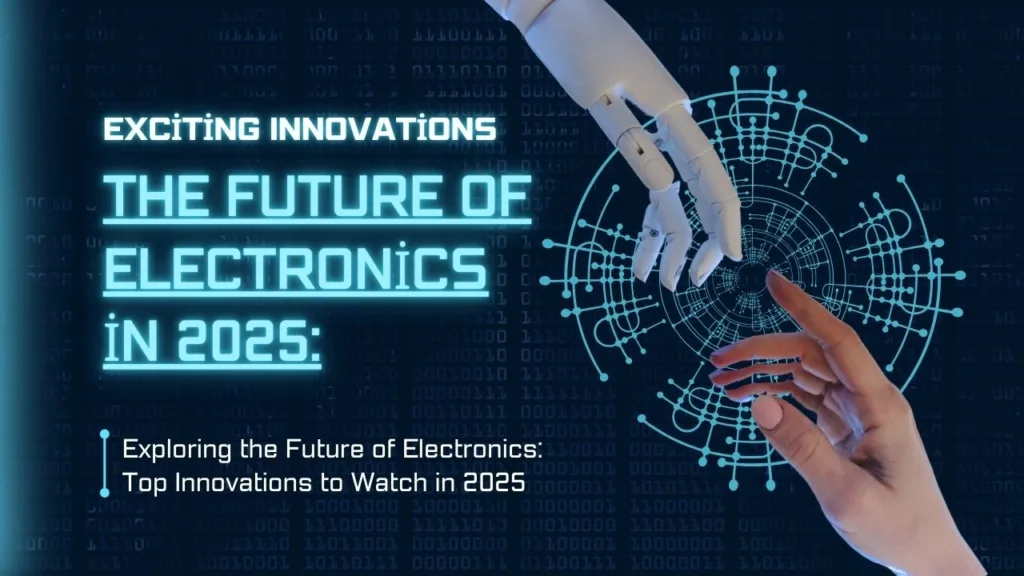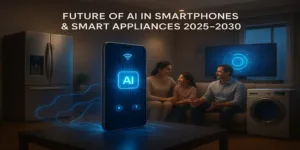The Future of Electronics in 2025: Exciting Innovations You Won’t Want to Miss!

Table of Contents
Introduction
The world of electronics is evolving at an astonishing pace, and 2025 promises to bring innovations that will change the way we interact with technology. From smarter gadgets to groundbreaking innovations, 2025 will usher in a new era of convenience, efficiency, and connectivity. Let’s dive into some exciting tech trends and products that we can expect to see by 2025.
1. AI-Powered Everything: Smarter Devices at Your Fingertips
Artificial Intelligence (AI) is already shaping many devices, but by 2025, it will be ubiquitous across all types of electronics. Imagine a home assistant that can predict your needs, appliances that adjust to your preferences, or even self-driving cars that navigate on their own. AI will take personalization and automation to a whole new level.
What to Expect:
- Intelligent Personal Assistants: AI-driven devices will become even smarter, understanding your voice commands more accurately and predicting your needs before you even ask. These assistants will help optimize everything from your home’s energy use to your work tasks.Example: Google Assistant & Amazon Alexa 2025 – These smart assistants will be able to fully manage your home by not only controlling lights and temperature but also recommending personalized content, shopping lists, and even wellness routines based on your behavior.
- AI-powered Appliances: Household appliances like refrigerators, washing machines, and air conditioners will anticipate your needs, adjust settings automatically, and even alert you when maintenance is required.Example: LG AI Smart Refrigerator (2025) – This fridge will be able to recognize the items inside, suggest recipes based on available ingredients, and send you reminders to reorder groceries when supplies are running low.
Why It Matters: As AI continues to improve, everyday tasks will become more intuitive, efficient, and personalized. Devices will no longer just respond to commands—they’ll learn, adapt, and proactively improve our lives.
2. 5G Connectivity: The Game-Changer for Speed & Performance
By 2025, 5G will have become mainstream, drastically improving internet speeds, reducing latency, and enabling new possibilities like augmented reality (AR) gaming, connected homes, and real-time telemedicine.
What to Expect:
- Blazing Fast Internet: With download speeds up to 100 times faster than 4G, 5G will allow for uninterrupted streaming, real-time video calls, and virtually lag-free gaming. This will open the door for new experiences like streaming 8K video or engaging in high-quality VR games.Example: Apple iPhone 15 (2025) – The latest iPhone will feature enhanced 5G capabilities, allowing for super-fast streaming of 8K videos, real-time multiplayer gaming, and seamless video conferencing, all with minimal lag.
- Connected Smart Cities: 5G will enable massive growth in smart city infrastructure. With its low latency and reliable connectivity, 5G will support smart traffic systems, real-time monitoring of pollution, and faster emergency response systems.Example: 5G-Powered Smart Traffic Systems (2025) – Cities will implement 5G-enabled systems that communicate with vehicles, adjusting traffic lights dynamically and reducing congestion by guiding vehicles based on real-time traffic data.
Why It Matters: 5G will be the backbone of the next-generation internet experience, making everything faster, more responsive, and interconnected.
3. Augmented Reality (AR) & Virtual Reality (VR): A New Way to Interact
By 2025, AR and VR will become deeply integrated into our daily lives, enhancing everything from shopping to work and education. These technologies will allow us to experience digital content in entirely new ways, blending the physical and digital worlds seamlessly.
What to Expect:
- Virtual Shopping: AR will make online shopping more immersive, allowing you to “try before you buy” by seeing how products look in your home or even on your body.Example: Apple AR Glasses (2025) – These augmented reality glasses will allow users to overlay digital information onto the real world. You could virtually try on clothes, place virtual furniture in your home, or even attend a concert from the comfort of your living room.
- Immersive VR Workspaces: VR will transform the workplace by allowing people to collaborate in immersive virtual spaces. Virtual offices, meetings, and project spaces will become the norm for remote work.Example: Meta Quest 3 (2025) – Meta’s latest VR headset will improve upon the Quest 2 with better graphics, improved comfort, and more realistic simulations, making it an essential tool for both entertainment and professional collaboration in virtual environments.
Why It Matters: AR and VR will change how we interact with the digital world, from how we shop to how we work and learn. The lines between physical and digital will blur, providing new opportunities for creativity and productivity.
4. Foldable & Flexible Screens: The New Shape of Devices
By 2025, foldable and flexible screens will become more practical, with improved durability, design, and user experience. These devices will allow users to have bigger screens while maintaining portability.
What to Expect:
- More Foldable Devices: Expect to see more foldable smartphones and tablets that combine the portability of a small device with the screen size of a tablet. The foldable display technology will improve, making these devices thinner, lighter, and more durable.Example: Samsung Galaxy Z Fold 6 (2025) – The newest iteration of the Galaxy Z Fold will feature a more durable foldable screen, allowing users to unfold the device to reveal a tablet-like display, perfect for multitasking and gaming on the go.
- Flexible OLED Displays: Flexible displays will move beyond smartphones to include wearables and even TVs, offering new design possibilities and more ergonomic ways to interact with devices.Example: LG’s Rollable TV (2025) – LG’s next-gen rollable OLED TV could allow users to unroll a massive screen from a compact form factor. It’s expected to revolutionize how we use TVs, saving space when not in use and offering a truly cinematic experience when rolled out.
Why It Matters: Foldable and flexible screens will offer users the ability to have larger displays without the bulk, providing a new level of convenience and usability in portable devices.
5. Sustainable Electronics: Green Tech is the Future
As the tech industry faces increased pressure to become more sustainable, electronics in 2025 will be built with the environment in mind. Expect energy-efficient products, recyclable materials, and longer-lasting devices that reduce e-waste.
What to Expect:
- Eco-friendly Materials: Electronics companies will increasingly use sustainable materials, such as recycled plastics and metals, and focus on reducing the environmental impact of manufacturing and disposal.Example: Fairphone 5 (2025) – This smartphone will continue the Fairphone tradition of using recyclable materials, modular components, and offering longer product lifecycles to reduce e-waste. Users will be able to easily upgrade parts, making it a more sustainable option compared to traditional smartphones.
- Energy-Efficient Appliances: Home appliances will become more energy-efficient, helping reduce both energy bills and environmental impact. Smart appliances will also be optimized to use less energy while maintaining top performance.Example: Whirlpool Smart Refrigerator (2025) – This fridge will use AI to optimize energy use based on household routines, automatically adjusting temperature settings and notifying users about energy-saving tips.
Why It Matters: Sustainability will be at the forefront of tech innovation by 2025, helping reduce the environmental footprint of consumer electronics while offering more eco-friendly choices for consumers.
6. Wearables: The Next Level of Health and Convenience
Wearable tech will continue to evolve, moving beyond fitness tracking to become essential tools for managing health, communication, and productivity. By 2025, wearables will offer more advanced health monitoring, seamless connectivity, and greater convenience.
What to Expect:
- Advanced Health Monitoring: Wearables will not only track steps and heart rate but will also monitor critical health metrics like blood glucose levels, blood pressure, and even early signs of diseases such as cancer or heart issues.Example: Apple Watch Series 9 (2025) – The next generation of the Apple Watch will feature groundbreaking health features, like blood glucose monitoring for diabetics and advanced fall detection for older adults.
- Smart Clothing: We’ll see clothing with embedded sensors that can monitor our health, adjust our body temperature, and even charge our devices as we wear them.Example: Samsung Smart Shirt (2025) – A T-shirt with built-in sensors that track vital signs such as heart rate and respiration, providing real-time health insights through a connected app.
Why It Matters: Wearables will become more integrated into daily life, providing health benefits, convenience, and continuous monitoring of our well-being in a seamless, non-invasive way.
Conclusion: The Future is Now!
As we look ahead to 2025, the future of electronics is brighter than ever. AI-powered devices, 5G connectivity, AR/VR, foldable screens, sustainable tech, and advanced wearables are just a few of the innovations that will shape the way we live, work, and play. These trends will not only make our lives easier but will also revolutionize entire industries, from healthcare to entertainment.
Get ready for a future where technology is smarter, faster, and more sustainable—because it’s coming sooner than you think!




Add comment